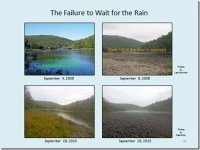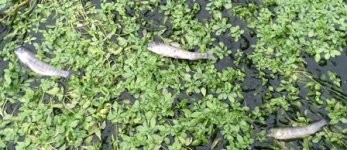krayfish2
Well-known member
I attended the ACOE meeting in Whitehaven yesterday. Prior to the meeting, several forum members got together and fished in the Lehigh Gorge area. During the comment period, one of the guys said “We had six guys fish for 5 hours. That’s 30 angling hours with zero fish caught. First impression is I probably wouldn’t come back.” (may not be verbatim but its close) Pretty sure I’ll be deemed a ‘smart azz’ for saying this but it’s true……… It’s called fishing and not catching for a reason. I could have happened on a stream 6’ wide or 400’ wide.
Over the past couple of years, I’ve taken upwards of 50 ‘big water newbies’ to some of my favorite fisheries. More times than not, the new guys have VERY limited success or no success at all. A majority of them say they will not come back. Why?
Here’s what I’ve observed over the last couple of years:
To most people in PA, Spring Creek is a medium / large trout stream and Penns is “Big Water”. I think the big water trout opportunities in this state are few and that’s why first timers become overwhelmed. The angler come unprepared to wade deep / swift water, change locations, change type of fishing method and unable to cast the required distance to reach many fish. They also seem to set unrealistic expectations due to fish pics posted by someone. I’d say PA trout fishing ‘big water’ might be limited to below Kinzua, the Yough, Lehigh, Delaware, Pine and maybe a few others. Do these rivers hold trout? Yes. Do they hold some very big fish? Absolutely.
Take a smaller stream that holds brookies and browns for example. I may consist of pools (15’ – 100’ long), shallow riffs, plunge pools, etc. The fish are often limited in their travel except during high water events. You can carefully approach a pool, make several casts and catch 1-2 fish. You walk 50 yards and repeat the process. In a 500 yard stretch, you may have fished over 25-30 pools and caught 20-30 fish.
Take the same scenario and put it on a big water stream. You first find a beautiful riffle entering a nice pool. First thing you notice is the riffle is 120’ wide and quite deep in some spots. It can be difficult for a big water newbie to read the section and figure out where the fish are sitting. Hell, it can be difficult for a veteran to find them sometimes. Due to difficulty wading and difficulty reading the water, the newbie decides to move to the top of the pool looking for risers. There are caddis and mayflies hatching in the riffs so it’s “game on”. They spot a pod of fish feeding and wade in looking to make a cast. They cast and cast but the fish can’t be reached. On big water, your depth perception seems to get skewed and what you think is 30’ away is actually 60’ away. The angler decides to wade closer so that they can reach the fish. Before you make a cast, the fish move out of range again. These fish are living in a pool that’s a mile long! If you violate their space, they simply relocate and keep feeding. The fish may also be passing through and live in that location for 1-2 months and then leave. This in particular is a tough thing for newbies to wrap their head around. You often have to approach the fish just as carefully as you would on a small brook trout stream. There are also times where you have to admit defeat or that a fish is in an uncatchable location.
Starting out in fly fishing, I frequented Clarks, the run at the Breeches, Big Spring, Spring, etc. My first big trout water was when an old timer took me to the Beaverkill. He gave me 6 patterns and turned me loose. I’d never seen water that big. I’d never seen so many hatches. I surely hadn’t caught fish that pulled so hard or were such a good average size. We made our spring trip a regular occurrence. Fly Fisherman magazine started publishing articles on the Delaware system right around that time. I tried to get the old timer to explore the Delaware system with me but he had no interest. “I only fish the Beaverkill and only use traditional patterns”. I started poking around on my own and know that I’ve put over 150 miles on the car in one day just driving from river to river and back again. Many days were spent sitting on a rock for 6-8 hours waiting for the hatch. What I didn’t realize was…..the hatch was over, I was in the wrong type of water of the fish had moved. I’ll bet my first 10 solo trips to the system yielded one 8” brown. Why would anyone subject themselves to that kind of punishment? Well, the day came where I guess correctly and got lucky. I landed 2 fish over 20” and one of them took all my line and I had to chase him like a foul hooked salmon. I never had backing on my reels back then because I’ve never needed it. LOL.
Maybe I’m a glutton for punishment, maybe it’s the stubborn Italian thing or I’m just nuts. I enjoy the challenge of reading the water, flinging off long casts to difficult lies, fighting the conditions and understanding / predicting the flows. Big water fishing isn’t for everyone but I encourage everyone to get with a guide or experienced person and give it a shot once. You might find that you love it or it’s just not your cup of tea. If you go in with ZERO expectations, you can only be pleasantly surprised with the results.
Over the past couple of years, I’ve taken upwards of 50 ‘big water newbies’ to some of my favorite fisheries. More times than not, the new guys have VERY limited success or no success at all. A majority of them say they will not come back. Why?
Here’s what I’ve observed over the last couple of years:
To most people in PA, Spring Creek is a medium / large trout stream and Penns is “Big Water”. I think the big water trout opportunities in this state are few and that’s why first timers become overwhelmed. The angler come unprepared to wade deep / swift water, change locations, change type of fishing method and unable to cast the required distance to reach many fish. They also seem to set unrealistic expectations due to fish pics posted by someone. I’d say PA trout fishing ‘big water’ might be limited to below Kinzua, the Yough, Lehigh, Delaware, Pine and maybe a few others. Do these rivers hold trout? Yes. Do they hold some very big fish? Absolutely.
Take a smaller stream that holds brookies and browns for example. I may consist of pools (15’ – 100’ long), shallow riffs, plunge pools, etc. The fish are often limited in their travel except during high water events. You can carefully approach a pool, make several casts and catch 1-2 fish. You walk 50 yards and repeat the process. In a 500 yard stretch, you may have fished over 25-30 pools and caught 20-30 fish.
Take the same scenario and put it on a big water stream. You first find a beautiful riffle entering a nice pool. First thing you notice is the riffle is 120’ wide and quite deep in some spots. It can be difficult for a big water newbie to read the section and figure out where the fish are sitting. Hell, it can be difficult for a veteran to find them sometimes. Due to difficulty wading and difficulty reading the water, the newbie decides to move to the top of the pool looking for risers. There are caddis and mayflies hatching in the riffs so it’s “game on”. They spot a pod of fish feeding and wade in looking to make a cast. They cast and cast but the fish can’t be reached. On big water, your depth perception seems to get skewed and what you think is 30’ away is actually 60’ away. The angler decides to wade closer so that they can reach the fish. Before you make a cast, the fish move out of range again. These fish are living in a pool that’s a mile long! If you violate their space, they simply relocate and keep feeding. The fish may also be passing through and live in that location for 1-2 months and then leave. This in particular is a tough thing for newbies to wrap their head around. You often have to approach the fish just as carefully as you would on a small brook trout stream. There are also times where you have to admit defeat or that a fish is in an uncatchable location.
Starting out in fly fishing, I frequented Clarks, the run at the Breeches, Big Spring, Spring, etc. My first big trout water was when an old timer took me to the Beaverkill. He gave me 6 patterns and turned me loose. I’d never seen water that big. I’d never seen so many hatches. I surely hadn’t caught fish that pulled so hard or were such a good average size. We made our spring trip a regular occurrence. Fly Fisherman magazine started publishing articles on the Delaware system right around that time. I tried to get the old timer to explore the Delaware system with me but he had no interest. “I only fish the Beaverkill and only use traditional patterns”. I started poking around on my own and know that I’ve put over 150 miles on the car in one day just driving from river to river and back again. Many days were spent sitting on a rock for 6-8 hours waiting for the hatch. What I didn’t realize was…..the hatch was over, I was in the wrong type of water of the fish had moved. I’ll bet my first 10 solo trips to the system yielded one 8” brown. Why would anyone subject themselves to that kind of punishment? Well, the day came where I guess correctly and got lucky. I landed 2 fish over 20” and one of them took all my line and I had to chase him like a foul hooked salmon. I never had backing on my reels back then because I’ve never needed it. LOL.
Maybe I’m a glutton for punishment, maybe it’s the stubborn Italian thing or I’m just nuts. I enjoy the challenge of reading the water, flinging off long casts to difficult lies, fighting the conditions and understanding / predicting the flows. Big water fishing isn’t for everyone but I encourage everyone to get with a guide or experienced person and give it a shot once. You might find that you love it or it’s just not your cup of tea. If you go in with ZERO expectations, you can only be pleasantly surprised with the results.






